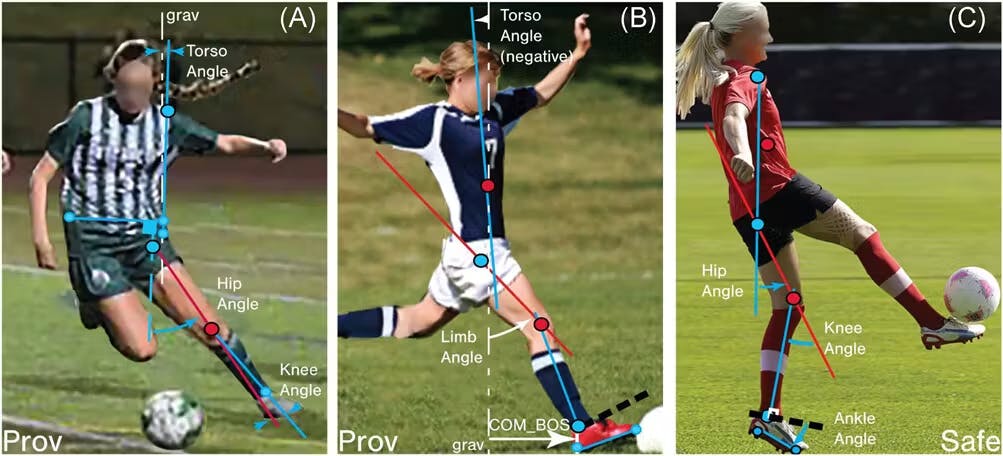ACL injuries are brutal. Over 100,000 reconstructive surgeries happen every year in the US alone — and many more athletes never make it back to full performance [1]. While there’s a mountain of research on treating these injuries, there's surprisingly little on how to prevent them in the first place.
At Hippos Exoskeleton Limited, we’re aiming to change that.
We’ve built the Smart Adaptive Knee Brace — a system combining our patent-pending sensor fusion system and a high-speed inflatable airbag to detect and prevent knee injuries before they happen. This article outlines how we tested our 9th-generation prototype on an artificial knee joint — and what we learned about real-time injury prevention.
The Science of ACL Tears
Most ACL injuries (about 70%) are non-contact — meaning they happen without physical impact from another player. Common scenarios include awkward landings from jumps or sudden changes in direction. The worst-case movement? When the tibia externally rotates while the knee is in a valgus (inward-collapsing) position, as shown in Figure 1.
This kind of twist happens fast. Research shows it takes only 60 milliseconds from the triggering movement to a full ACL tear [3]. That leaves very little time to react — but we believe it's enough.
Our Approach: Instantaneous Airbag Deployment
We focused on two goals:
- Accurately measure tibial rotation angle using our proprietary sensor fusion system.
- Inflate an airbag around the knee fast enough to stop dangerous motion.
To simulate knee movement without risking real injuries, we built an artificial knee joint.
Building an Artificial Knee for Testing
Since we couldn’t test on actual humans, we created a synthetic knee using a combination of anatomical models, 3D scans, and ballistic gel.
Here’s how:
- We 3D scanned a human leg and an anatomical knee model.
- Using Blender and Fusion 360, we scaled and processed the meshes, aligning joint positions.
- We designed and printed a mould of the leg, then poured ballistic gel (to simulate human tissue) around the anatomical model in layers.
The result was a test rig with realistic joint constraints and mechanical properties.
Smart Adaptive Knee Brace: How It Works
Our prototype brace features:
- Our patent-pending sensor fusion system to measure tibial rotation
- An airbag integrated into the brace, powered by an explosive-seal CO₂ cartridge
- Embedded electronics on a bespoke flexible PCB
Once a dangerous tibial rotation is detected, the brace inflates to restrict further motion.
Results: 30 Degrees to 0 in 20ms
We tracked the tibial rotation angle in real time. During testing, we deliberately twisted the artificial joint. Here’s what we observed:
- The tibial rotation angle spiked to 32° (shown as the X-axis measurement in our data)
- After airbag inflation, the angle returned to 0°
- Time taken: 20ms
This is significant. An ACL tear happens in 60ms [3] — and our brace countered the twisting motion in only 20ms.
What This Means
This initial test suggests the Smart Adaptive Knee Brace could realistically prevent ACL injuries by reacting faster than the injury develops. The system doesn't just measure — it acts.
We still need further testing under:
- Varying torsional loads
- Prolonged stress scenarios
- Real-world comparison of IMU data with ground truth rotation angles
If results hold up, we’ll progress to testing on cadaver joints — a crucial step before human trials.
Conclusion
We’ve shown that:
- Our sensor fusion system can effectively measure tibial rotation
- A real-time system can react fast enough (20ms) to counteract risky joint movements
- The Smart Adaptive Knee Brace shows real promise in preventing, not just treating, knee injuries
This could be a step-change in sports injury prevention.
References
- B. D. Beynnon et al., "Treatment of ACL Injuries", Am J Sports Med, 2005
- B. P. Boden, F. T. Sheehan, "Mechanism of Non-Contact ACL Injury", J Orthop Res, 2022
- T. Krosshaug et al., "Mechanisms of ACL Injury in Basketball", Am J Sports Med, 2007


